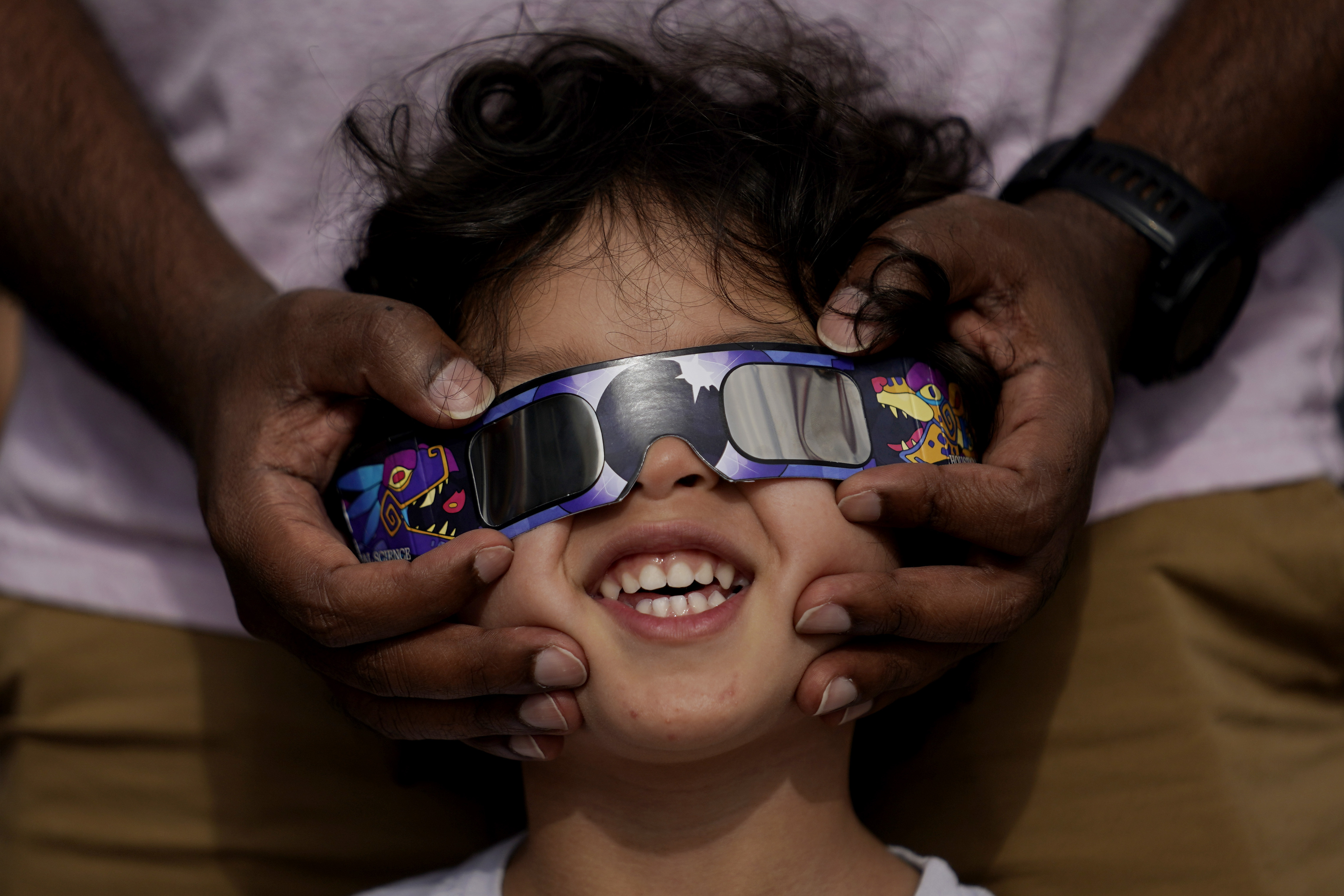Through cloudy skies, a stunning solar eclipse dazzled North Texas Monday as it began its push northeast across the United States and North America.
While Texas was in the path of totality, many other parts of the country will see only a partial eclipse. Scroll down to see a collection of stories leading up to the eclipse and new stories added live as the eclipse unfolded Monday.
When was totality over North Texas?
Get top local stories in DFW delivered to you every morning. Sign up for NBC DFW's News Headlines newsletter.
The solar eclipse occurred over North Texas beginning with a partial eclipse at 12:23 p.m. and ending at 3:02 p.m. Totality only lasted minutes, from about 1:40 p.m. until 1:44 p.m., depending on location.
The event is truly a rare occasion.
Another total solar eclipse won't occur over the United States until 2044 and the National Weather Service says there won't be another in our region until 2317.
Totality over North Texas, time-lapse videos
See the time-lapse videos below of totality over North Texas.
Totality over North Texas, real-time
See the videos below of totality over North Texas, recorded in real-time.
Photos: Total eclipse over North Texas
See a collection of photos from Telemundo 39 journalist Jose Antonio Hererra, taken outside the NBC 5/Telemundo 39 studios at Centerport.
Photos: Total eclipse over North Texas
What was the path of totality?
What were those red blobs coming out of the sun during the eclipse?
By: Frank Heinz and Kevan Smith
Did you see those red blotchy areas around the sun during Monday's total solar eclipse?
Those are called solar prominences. Though they look like they could be made of fire, they are actually eruptions of plasma, a hot gas made of electrically charged hydrogen and helium, extending outward from the sun's surface.
Solar prominences flow along a magnetic field the sun generates and can last for several months. The prominences can extend into space as far out as 200,000 miles, nearly the distance between the Earth and the moon -- that's roughly 28 times the diameter of our planet.

So, what's the difference between a prominence and a solar flare or CME?
Prominences are anchored to the sun's photosphere, the lowest level of the sun's atmosphere, and aren't ejected into space.
Solar flares, NASA said, are giant bursts of X-rays and energy that shoot from the sun into space at the speed of light. Traveling at that speed, solar flares can reach the Earth in about eight minutes where they can cause disruptions to satellites and communications in the Earth's atmosphere.
CMEs are also ejected into space but are slower than flares and travel at about 5% the speed of light, or roughly 9,300 miles per second. At that speed, it can take between one and three days for a CME to reach Earth.
When the CME's cloud of electrically charged particles passes the Earth, some are drawn to the magnetic poles and interact with atoms and molecules in our atmosphere, causing the aurora borealis in the northern hemisphere and the aurora australis in the southern hemisphere.
Prominences, which remain tethered to the sun, have no impact on the Earth.
Did you see those mysterious twinkles before and after the total solar eclipse?
If you witnessed April 8's total solar eclipse, you might have noticed a mesmerizing phenomenon that occurred just before and after the celestial event.
They're called shadow bands–thin, wavy lines of alternating light and dark that move and undulate parallel on plain-colored surfaces.
According to NASA, these bands' intensity, motion, and direction seem to be related to the same spectacle that makes stars twinkle. In the upper atmosphere, turbulent cells of air act like lenses to focus and defocus the sharp-edged light from the solar surface just before totality.
The movement of these atmospheric cells is random between each eclipse and each viewing location, so the appearance and movement of shadow bands cannot be predicted beforehand.
Watching these shadow bands move and shimmer on the ground is fascinating. They typically appear about a minute before the total solar eclipse and last for a few seconds to a few minutes after.
The best way to view these bands is to have a plain-colored surface, such as a white sheet or a concrete pavement. The effect is most prominent in areas with good visibility and light-colored surfaces.
The phenomenon of shadow bands has puzzled scientists and eclipse watchers for centuries. Although they are not rare during a total solar eclipse, they are still not fully understood.
Some theories suggest that the shadow bands result from the interference of light waves caused by the Earth’s atmosphere. Others suggest they result from the bending of light by the Earth’s magnetic field.
So the next time you witness a total solar eclipse, which will be sometime between 2024 and 2025, keep an eye out for these elusive shadow bands and marvel at the beauty of nature's mysteries.
Travelers on Southwest Airlines flight capture stunning solar eclipse photos
By: Candace Sweat and De'Anthony Taylor
Millions of people around the United States looked up to the sky in awe as they watched the total solar eclipse, an incredible phenomenon that only happens once in a lifetime.
However, a group of lucky travelers had a unique experience they will never forget as they witnessed the eclipse at 35,000 feet.
Southwest Airlines, one of the country's most popular airlines, hosted a one-of-a-kind inflight "Solarbration" for its passengers, complete with festive eclipse-themed glasses, napkins, and cosmic cocktails.
The airline said its Solarbration flights that were within the path of the eclipse included Southwest Flight #1252, which departed Dallas (Love Field) for Pittsburgh; Southwest Flight #1721, which departed Austin for Indianapolis; and Southwest Flight #1910, which departed St. Louis for Houston (Hobby).
Passengers onboard these flights were treated to a front-row view of the eclipse, making their journey even more memorable and exciting.
Southwest Airlines catches stunning photos of total solar eclipse amid ‘Solarbration'
But that's not all—leading up to the eclipse in March, Southwest Airlines said it partnered with Omni Hotels to host a Solarbration Sweepstakes. The sweepstakes awarded two lucky winners and their guests an out-of-this-world eclipse experience.
The winners enjoyed a decked-out eclipse-themed room at the Omni Hotel in Austin or Dallas before heading to the airport to begin their celestial adventure aboard a Southwest Airlines flight within the eclipse path. The Omni Hotels provided glasses, napkins, and stir-sticks for the flights, including a luggage tag with special offers.
As the entire world looked up to the sky in wonder on Monday, Southwest Airlines took it a step further by leveraging its place in the sky to provide a unique opportunity for its passengers to observe the phenomenon up close.
The airline's Solarbration flights allowed passengers to witness the eclipse from a whole new perspective, and the festive atmosphere onboard made the experience even more memorable.
Proposal of a lifetime: Couple gets engaged during solar eclipse in North Texas
In a world where love and cosmic events collide, Austynn Harbison and Alex Hoffpauir's love story is one for the ages.
Against the backdrop of the total eclipse at Murrell Park in Flower Mound, Texas, overlooking the serene waters of Grapevine Lake, Austynn said yes to forever with Alex in a breathtaking display of love and wonder.
Austynn and Alex met in 2016 at band camp. After three years of friendship and dating other people, they decided to take the plunge and officially date.
Alex is a designer at GHC in Lake Charles, and Austynn is a Veterinarian technician and runs a small business that makes dog and cat treats called Happy Dance Supply.
According to the couple, they knew they wanted to spend their lives together despite the challenges of moving and COVID-19 in the past five years.
After weeks of planning, Photographer Macy Alex told NBC 5 that she and Hoffpauir chose Murrell Park, with its panoramic cliffs, as the perfect spot for the proposal, which aligned with the eclipse.
The couple said their day started with a casual ramen lunch at the newly opened Ramen Akira at Lakeside. Little did Austynn know, their adventure would end with her as a fiancé.
During the total solar eclipse, Alex proposed to Austynn by presenting her with a stunning sapphire ring from Staghead Designs and asking for her hand in marriage. Macy captured the perfect moment when the diamond effect occurred.
"I couldn't believe I got it," exclaimed Macy Alex, reflecting on the capture of the once-in-a-lifetime shot. "I was shocked and so excited to edit it! I ran home right after the shoot and got it online as soon as possible."
"It was exactly what I had pictured," remarked Alex Hoffpauir, the mastermind behind the proposal.
"Macy helped my plan become a reality; I just really wanted it to be special for Austynn."
PHOTOS: Newly engaged couple gets the shot of a lifetime with 2024 solar eclipse
Following the proposal, the newly engaged couple savored the moment with apple cider and a brief photoshoot.
“It really is one of the best images of my career,” said Macy.
“I am so honored that so many people love it as much as I do, and I’m so excited that I was able to capture that moment for Austynn and Alex!”
Congratulations, Alex and Austynn!
Artist captures solar eclipse by harnessing sun power
By: Lucy Ladis
Michael Papadakis captured the total solar eclipse in North Texas in a special way.
The artist used heliography, a technique that harnesses and focuses the sun's rays using mirrors and lenses, to burn a landscape into a wood canvas.
Papadakis, known as Sunscribes on social media, blends science, art and ancient photographic techniques to use the sun like a paintbrush to create his artwork. During the 2024 solar eclipse, he created a landscape of Dallas' skyline.
The artwork is on display at Ripley’s Believe It or Not! in Grand Prairie.

Did you look at the solar eclipse without glasses? How to know if your eyes are damaged
By: Jermell Prigeon
Millions of Americans caught glimpses of a once-in-a-lifetime solar eclipse Monday afternoon. While many wore protective glasses, some ignored safety guidance and watched with their bare eyes.
Staring directly at the sun during a solar eclipse or at any other time can lead to permanent eye damage. The eclipse is only safe to witness with the naked eye during totality, or the period of total darkness when the moon completely covers the sun.
That is why eye doctors emphasized the importance of wearing proper eclipse glasses during the event.
Symptoms of solar eye damage -- called solar retinopathy -- include watery eyes and color distortion, according to Cleveland Clinic experts. People who may have damaged their eyes during the eclipse may also experience headaches and photophobia (sensitivity to light).
More serious symptoms of solar retinopathy include:
- Blurred vision.
- Eye pain.
- Metamorphopsia (straight lines appear rounded).
- Micropsia (objects appear smaller than they are).
- Scotoma (a blind spot in your line of sight).
Doctors say symptoms can appear anywhere within hours or days after the injury and advise individuals experiencing them to immediately seek medical attention.
Click here to read more on this story.
The eclipse is over, so what do you do with your eclipse glasses? Donate them!
So the 2024 total solar eclipse over Texas has come and gone. What do you do with those eclipse glasses? Donate them!
Click here to find a list of locations, local and by mail, where you can donate your gently used glasses.
NASA gets cheeky with the moon account
Arlington ISD solarbrates Moonday
The eclipse on the UT Arlington campus
President Joe Biden
Sun Cam: Dedicated shots of the sun throughout the eclipse
In the feed below, we'll rotate through live shots of the sun from locations around North Texas, northeast Texas and southwestern Arkansas.
(This video has concluded)
Totality in Mazatlan, Mexico
At about 1:10 p.m., the eclipse reached totality over Mazatlan, Mexico.
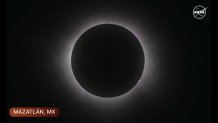
Eclipse begins over North Texas
A view of the eclipse beginning over Dallas, taken at about 12:35 p.m. on Monday, April 8, 2024.
The eclipse will end at 3:02 p.m. Totality will last only minutes, from about 1:40 p.m. until 1:44 p.m., depending on location.
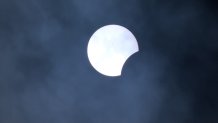
Woman flies from Sydney, Australia to Dallas to witness a total eclipse
A camper at Totality Dallas' Samuell Farm viewing event shared her excitement to see the total eclipse.
Kasia traveled from Sydney, Australia to Dallas to watch the historic event.
"I saw there was a direct flight from Sydney to Dallas and I thought '15 hours? And I can see this? Of course!'" Kasia said.
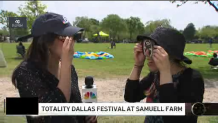
Carrollton students go station to station studying the eclipse
Outside of Country Place Elementary School in Carrollton, NBC 5's Wayne Carter visited with students studying the eclipse.
The school set up stations around the schoolyard to teach the students about the eclipse. Some students made pinhole cameras while others were able to use tools to project shadows on the ground.
"We've done two stations so far and they're fun. This is, like, a once-in-a-lifetime experience, really," said Jackson, a student at the school.
Click here to read more on this report.
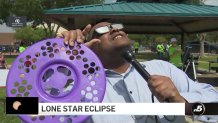
Skywatchers fill tiny Russellville, Arkansas, awaiting the total eclipse
NBC 5 headed into Russellville in southwestern Arkansas to check out the total eclipse as it moved out of the Lone Star State.
Russellville is in the western part of the state, west of Little Rock and east of Fort Smith. The town normally has about 29,000 residents but is packed with guests on Monday.

Crowds begin to fill Klyde Warren Park in Dallas
By: Lucy Ladis
People are gathering across Kyle Warren Park to watch the solar eclipse.
Those in the park are enjoying food trucks and a panel discussion with astronomers from the Carnegie Institution for Science presented by the Perot Museum while they wait for the event to start.
Complimentary eclipse-viewing glasses are also being handed out at the event.

Eclipse begins in Southern Texas
Robert Lozano in Bulvarde, Texas has his own observatory in Blanco County. At an elevation of 1,684, feet, this shot was shared early Monday afternoon as the moon began to eclipse the sun.

Veteran takes once-in-a-lifetime eclipse flight out of DFW
NBC 5's Candace Sweat is boarding an eclipse flight out of Dallas. While waiting to board, she met fellow passenger Herman Hardy, a 75-year-old veteran of the Vietnam War who flew from Pittsburgh to join up with the flight following the eclipse.
North Texans share photos from 2024 total eclipse
North Texans share photos from 2024 total eclipse
Why is a solar eclipse the perfect time to study the sun? UTA Planetarium director has the answer
Levent Gurdemir, the director of the Planetarium at The University of Texas at Arlington talks about what scientists will be looking at during the eclipse and why an eclipse is the perfect time to make observations.
"There is one thing that is not normally visible is the gas layer around the sun, called the corona. That layer is important because that gas layer produces a lot of plasma particles because of the temperature. And those plasma particles are actually interesting for us because sometimes they can damage our satellites and those are the ones that actually causing Northern Lights. It's something we continually monitor," Gurdemir said.
Because normal sunlight is so dominant in the sky, Gurdemir saidcool opportunities like a total eclipse allow scientists the unique opportunity to observe the corona without filters.
"Studying that gas layer is not really easy because we cannot see … it's not allowing us to get detailed images and data from the gas layer. A total solar eclipse is a perfect opportunity for us."
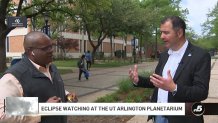
TODAY Show co-host Al Roker visits North Texas for the eclipse
Al Roker joined NBC 5’s Diana Zoga outside the Perot Museum in Dallas Monday morning. The TODAY show host reflected on his reporting from the 2017 solar eclipse.
Roker watched the previous total solar eclipse from the USS Yorktown deck where he remembered lighting and thunder surrounding the ship, until right before the celestial event started.
“It’s just one of these miracles of nature,” Roker said. “We realize there’s something bigger than us and that we can all take part in a communal sense.”
'Is the eclipse coming? Why can't I see the moon?'
NBC 5 Chief Meteorologist Rick Mitchell explained Monday morning why people looking up ahead of the eclipse can't see the moon approaching the sun.
Mitchell explained that the moon is in a phase called a "new moon" and you can't see a new moon.
"That's one of the reasons why this eclipse is possible because it has to be in that new moon phase and that's why you wouldn't see it moving across the sky, it's kind of invisible to us," Mitchell said. "We will certainly experience the shadow that it creates."
North Texas students gather at Cotton Bowl stadium for a celestial show-stopper, Neil deGrasse Tyson address
By: NBCDFW Staff
NBC 5's Noelle Walker talks with 3rd grade teacher Tristan Cojoe and 4th grader Ariana Lucky from Dallas's St. Anthony Academy at Cotton Bowl Stadium in Fair Park who said they were excited and grateful to be sharing such a special event with so many other students.
"Science is never-ending. To be able to explore new things and bring new journeys to them and experience things they've never done before and to learn, 'Hey, science is actually cool! It can be fun!"
"I feel very lucky!" said Lucky, who said she'd never seen a partial or full eclipse before.
Famed American astrophysicist, author, and science communicator Neil deGrasse Tyson was expected to address the students gathered at the Cotton Bowl. Tyson is a UT alum and the director of the Hayden Planetarium at the Rose Center for Earth and Space in New York City.
Click here to read more on this story.
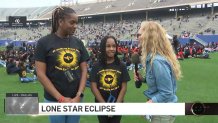
Omens of doom: How different cultures explained eclipses throughout history
By: Sara Sanchez
The modern world has a solid understanding of the way solar eclipses work. Thanks to science, we know that on April 8, 2024, much of North America will experience a solar eclipse. The sun, Moon, and Earth will align, in that order, leading the moon’s shadow path to land on Mexico’s coast before crossing the United States from Texas to Maine.
Scientific organizations like NASA have been able to map out not only where and when eclipses happen, they’ve also managed to use solar eclipses to learn about the sun and its influence on the world around us.
Even with prediction science, the experience of a total solar eclipse is often an overwhelming one. People describe an eerie sensation as the sun becomes overshadowed and darkness overcomes an otherwise bright sky. Even seasoned eclipse chasers report feeling overcome.
Click here to read more about this story.
How fast is the moon's shadow moving across the ground in North Texas?
NBC 5 Chief Meteorologist Rick Mitchell asks a weather-related trivia question every day. On Friday he asked, how fast is the moon's shadow moving across the ground in North Texas. See the answer below.
How clouds, high or low, can impact your view of the solar eclipse in Texas
By: Adrienne Vonn and Kevan Smith
We're all hoping for clear skies over North Texas for the total solar eclipse on April 8, but it's looking more and more like we won't be so lucky.
Clouds can play a vital role in what you see and can't see during a total solar eclipse, but not all clouds are created equal. Different types of clouds can have a different kind of influence on your viewing chances.
High clouds are expected to stream into North Texas during Monday's eclipse. High clouds can obscure the sun, diminishing the viewing experience. However, since high clouds are typically thin and fairly transparent, many aspects of the eclipse will still be visible.
There is a potential for some low clouds to arrive across parts of the area. Low clouds will make viewing the eclipse harder, especially if they are stratus clouds.
Temperatures are also impacted during an eclipse. During October's annular eclipse, the temperature at DFW Airport dropped 3 degrees during the eclipse. The temperature drop is most pronounced in areas with clear conditions, low humidity and light winds. A dip of anywhere from 1 degree if it's cloudy, and up to 8 degrees if it's clear, calm and dry.
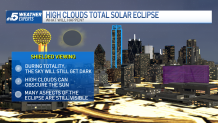
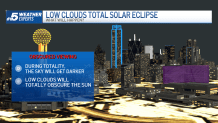
Share your photos and videos with us and they may be used on TV
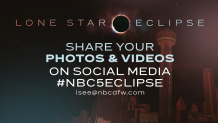
Want to watch the eclipse with a group? Here is a list of public viewing events
If you want to do more than walk out of your office or home to watch the eclipse, we have the list for you.
There are dozens of public viewing events planned around North Texas.
You can check out the ever-growing list here.
TxDOT prepares for increased traffic on ‘Eclipse Day'
By: Larry Collins
About a million people are expected to travel to and through Texas for a view of the eclipse in totality on Monday.
TxDOT urges those who live in the areas of totality to gas up during the weekend and be prepared for heavy traffic.
From border to border, there are 480 miles of Texas in the “path of totality,” which means there will be an influx of eclipse tourism and packed highways across the state.
TxDOT said its number one goal is to keep roads open and traffic moving and that takes increased planning and manpower.
Crews have equipment and traffic signs to help direct traffic and will have 24-hour emergency operations on Eclipse Day.
Drivers may notice a change to highway signs. They will say, “No stopping on the highway to view eclipse” and “No parking on the shoulder. Keep moving.”
“It's really important to not try to view this eclipse while driving you know you can't drive distracted you can't be looking in the sky and then also be looking on the on the road,” TxDOT representative, Adam Hammons said. “Don't have eclipse glasses on while driving it may sound obvious but those eclipse glasses are there to block the sun so they're going to limit your vision as well.”
TxDOT crews will also stop some road construction and maintenance work on major corridors in the path of the eclipse.
Driving during the eclipse? Here's what you should know
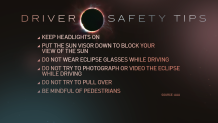
North Texas airports brace for crowds ahead of solar eclipse spectacle
By: Alanna Quillen
Get ready for a busy weekend – thousands of travelers are expected to arrive in North Texas to see the total solar eclipse on Monday.
That means the arrivals terminals at DFW International Airport and Dallas Love Field – the gateways to the region – will gradually get busier in the days leading up to April 8.
Experts say all airports along the path of totality are treating the event like a busy holiday weekend, with officials forecasting Sunday and Monday morning to be the biggest days for travelers heading to the eclipse viewing locations.
The Federal Aviation Administration has even issued a warning for pilots, airports, and travelers of potential travel delays across the eclipse path.
“There may be a higher traffic volume than normally anticipated at airports along the path of the eclipse. Traffic should anticipate delays during peak traffic periods. Parking may be limited – particularly at the smaller, uncontrolled airports. There could be a delay with the issuance of IFR departure clearances. VFR departures may also expect delays for airborne pickup of IFR clearance within 50 NM on either side of the path of the eclipse,” the agency said in a statement.
While the number of expected visitors to Dallas is unknown, city leaders are relying on information shared from Nashville during their 2017 solar eclipse. That city saw a 35% increase in population, which, according to city leaders, would translate to about 400,000 additional visitors to Dallas.
Click here to read this full report.
Can you take a picture of the solar eclipse? An astrophotographer says yes, and here's how
By: Brad Fosler
A solar eclipse is one of the most amazing phenomena people can see from Earth, and many Americans will be able to view one as it traverses parts of the United States on April 8.
The moon slowly covers the sun, creating a life-changing sight that goes away in minutes or even seconds.
What if you want to capture the moment for posterity? How can you best take photos of a solar eclipse?
Expert photographers who frequently capture incredible images of space while firmly on the ground say even amateurs can try their hand at capturing the eclipse.
Read more about it here or watch the video below.
Wear these colors to enhance the viewing experience of April's total solar eclipse
During these cosmic phenomena, viewers typically watch them in groups or public places such as libraries, parks, festivals, and parks with their eclipse glasses. But not many people know the rest of their wardrobe could improve their entire experience.
Experts at Solar Eyeglasses share tips on what colors viewers should wear to enhance their experience of watching the Great American Solar Eclipse and explain the science behind why these particular colors matter.
How do animals react during a total solar eclipse?
By Christina Larson | The Associated Press
When a total solar eclipse transforms day into night, will tortoises start acting romantic? Will giraffes gallop? Will apes sing odd notes?
Researchers will be standing by to observe how animals’ routines at the Fort Worth Zoo in Texas are disrupted when the skies dim on April 8. They previously detected other strange animal behaviors in 2017 at a South Carolina zoo that was in the path of total darkness.
“To our astonishment, most of the animals did surprising things,” said Adam Hartstone-Rose, a North Carolina State University researcher who led the observations published in the journal Animals.
While there are many individual sightings of critters behaving bizarrely during historic eclipses, only in recent years have scientists started to rigorously study the altered behaviors of wild, domestic and zoo animals.
Read more about the research here.
Blind people can hear and feel April's total solar eclipse with new technology
By Christina Larson | The Associated Press
While eclipse watchers look to the skies, people who are blind or visually impaired will be able to hear and feel the celestial event.
Sound and touch devices will be available at public gatherings on April 8, when a total solar eclipse crosses North America, the moon blotting out the sun for a few minutes.
“Eclipses are very beautiful things, and everyone should be able to experience it once in their lifetime,” said Yuki Hatch, a high school senior in Austin, Texas.
Hatch is a visually impaired student and a space enthusiast who hopes to one day become a computer scientist for NASA. On eclipse day, she and her classmates at the Texas School for the Blind and Visually Impaired plan to sit outside in the school’s grassy quad and listen to a small device called a LightSound box that translates changing light into sounds.
When the sun is bright, there will be high, delicate flute notes. As the moon begins to cover the sun, the mid-range notes are those of a clarinet. Darkness is rendered by a low clicking sound.
Rock out to these 20 songs during the 2024 total solar eclipse
By Maria Sherman | The Associated Press
The total solar eclipse is quickly approaching. While you prepare to hit the road toward the path of total darkness or anticipate hours of traffic coming out of your watch party, you'll need something to listen to. And we've got your back.
Across 20 tracks, here's a comprehensive playlist of total solar eclipse (and total solar eclipse-adjacent) songs to listen to while preparing to take in the wonders of the universe on Monday. Listen to the full playlist on Spotify.
There is no more appropriate song than Bonnie Tyler’s karaoke classic, “Total Eclipse of the Heart.” Try not to start a sing-along with this one.

